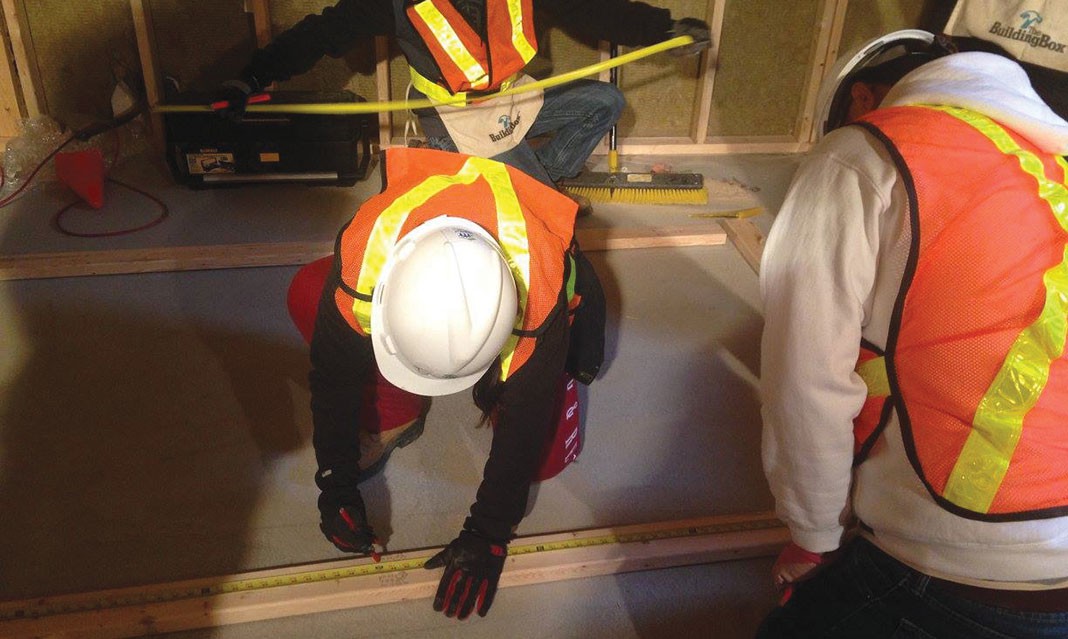A safe place to call home—it’s something that many of us take for granted.
On October 24, a group of 23 UTM students visited a Habitat for Humanity site in Milton to take part in the construction of a townhouse. The project was organized through the efforts of Student Life and UTM’s Habitat for Humanity club.
If you’ve never heard of Habitat for Humanity, it is an organization dedicated to providing affordable and safe housing to low-income families. Families who apply to receive a habitat must go through a process of interviews and are selected based on a set of criteria, which includes the type of housing they require as well as their ability to finance their house.
Contrary to how it may look, Habitat homes are not free. The families who occupy them must still pay a mortgage. However, they pay a no-interest, no-profit loan, and virtually no down payment. The organization has built sites worldwide, but at a local level, its operations depend almost entirely on volunteer efforts and charitable donations from the community.
What I found most enticing about this volunteer project was the hands-on nature of the work. When working with large non-profit organizations, volunteer work tends to mainly involve fundraising. While bake sales are all well and fine, sometimes it can be hard to feel like you’re making a difference when you can’t see how your donation has helped someone.
What makes Habitat for Humanity different is that while they accept donations, they rely heavily on volunteer efforts in the construction of their homes. Everyone, from the experienced homebuilder to the novice Property Brothers fan, is welcome at the site.
When we arrived at the build site, each student received the equipment that they would need for the day, including steel toe boots, a hard hat, and safety goggles. After going over some safety precautions, students split off into groups, with each group tackling a different project for the day.
My group was tasked with building the last section of a wooden wall frame needed to complete a basement wall. My group leader, Allan, explained to us how he started volunteering for Habitat after he had retired from accounting, and how every day at the site he learned something new.
The first thought that hit me when I walked into the unfinished townhouse was the smell. One of my favourite smells is the smell of Home Depot. The smell of lumber in the house felt cozy, warm, and authentic.
The second thought I had was about how beautiful the house looked. Everything I saw was wooden, since only the bones of the house had been built so far. The walls consisted only of wooden frames, and so all the open space made the house feel huge. When you take away the hardwood floors and stainless steel appliances, a work of craftsmanship remains.
Outside the house, there were two posts. Each post contained a small description about the families who would be moving into the completed townhouses. The posts also contained messages that thanked the volunteers who were helping to build their homes. Reading the signs, I felt like I was contributing towards the project. Knowing the name of the person I had helped make my contribution seem significant, even if only a little.
My group leader was very patient with our team and taught each of us how to use tools ranging from a chop saw (a large industrial woodcutter that has a spinning metal blade) to the humble hammer. While some members of our team were more experienced than others, the entire atmosphere at the site was one of encouragement and teamwork, with everyone contributing something to the project. I’ll admit that the first time I used the chop saw, I felt intimidated. But with Allan’s guidance, by the end of the day I was chopping like a pro and enjoyed using a tool that once seemed so scary.
At the end of the day, each UTM student received markers to sign the built frames. Volunteer names were littered across the house along with small messages for the new homeowners.
“It was a good experience and I met new people,” says UTM’s Habitat for Humanity’s outreach director and second year criminology student Zaryaab Rauf. “It was something different from some of the other volunteering experiences [that I’ve taken part in]—it was more hands-on.”
According to Rauf, while 23 UTM students attended the build project, there was a waitlist of approximately 60 students. Only a maximum of 25 students could attend due to the limited volunteer opportunities available.
When students were asked what they would tell other UTM students regarding the event, every answer was overwhelmingly positive. Many volunteers noted that this was one of those volunteer projects in which they felt like they were actually making a difference. From meeting new people to gaining practical life skills, doing fun hands-on work, and finally getting our heads out of the books for a day, there was so much to be gained by volunteering for a Habitat build.
Allan told our group that he’d never had a bad day on the site. As everyone left the site smiling, I believed him.



